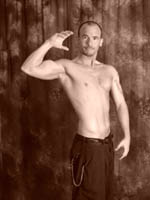 Before |
 After |
 After |
 After |
The Body as Extension of the Mind
Soccer player Marco Antonio “El Diablo” Etcheverry’s mind has the ability to calculate the velocity, trajectory, and spin of a soccer ball on the playing field and kick it with at precisely the right spot with the perfect amount of force to redirect it into a goalie’s box. He does all of this within a fraction of a second. That action requires intelligence just as powerful as mathematic or linguistic.
Kinesthetic Intelligence is centralized in the brain, but extends beyond it to our bodies, nerves and muscles, and beyond that to the physical world around us. Maintaining our health requires learning and adaptability. We must exercise the power of our neocortex over our basic urges in order to maintain a diet and regular exercise. We must keep up with health literature and refine our behaviors appropriately to closely model the best health practices of the day.
Remember the malleable nature of IQ, something we have a degree of control over. There are many types of intelligence and physical fitness is simply another realm of study. Like learning calculus, chemistry, or English, physical fitness requires study and application. Read about how to work out and eat, and then apply that knowledge to our bodies. Experiment, observe the results, and adjust hypotheses appropriately.
Muscles Have Memory
I, like most real-life people, have fallen off the exercise wagon from time to time, usually for stretches anywhere from 6 months to a year. When this happens, my gut expands and I must buy bigger clothes. Eventually I reach a threshold where I can’t stand anymore.
So I trudge back to the gym. The first two-to-four weeks are hell, but I quickly remember how to enjoy the pain that comes with it and soreness that follows. I’ve gone down in strength, but it returns quickly, and the best part is how quickly my muscles return. In no time at all, I am right back to where I was a half year ago, and the rest is progress. We don’t lose the gains we make in the gym quickly. I put on 25lbs of muscle in one year, and it was still there after a six-month break.
I got into physical fitness because I was looking for a confidence-booster to help overcome my social phobia. It did help improve my confidence and improved my emotional health as well (I’m still working on the social phobia). The following posts will relate what I have learned in five years of off and on exercising and cognitive dieting.
Exercise
Gym Advice
If we engage physical fitness using the scientific method, then we must follow a process of observation, hypotheses, experimentation, and theory. Our fellow enthusiasts at the gym are our peers and help with the review process. Our peers will offer much advice, offering us opportunities to compare notes:
“Don’t count reps, just go until you can’t go anymore.”
“Start with low weight to warm up and then go high.”
“Go with high weight and move to low to fully tax your muscles.”
“Supplement with creatine… ZMA… Whey Protein… multi-vitamins… etc. etc.”
“Take a week break every now and then to give your muscles building time.”
“Don’t drink water to prevent cramping.”
“Drink lots of water to keep hydrated.”
“Don’t stretch to keep your muscles fat.”
“Stretch to increase circulation to your muscles.”
As we can see, some of this is contradictory. Some of this, even the contradictory stuff, is good advice. Some of this is just plain wrong. Only through observation, hypotheses, experimentation, and theory can you extract the enduring truths from the hearsay.
Decide On A Body Type
Some women are “Petite Softies,” others are “Amazonian Goddesses.” Men have body-type choices too; they can go “Hulk” or “Athletic.” Decide on a body-type and go for it. We should look around the gym for someone of the same sex who looks like what we want to look like and take note of what they do.
This is not hard to tweak, and it’s almost all about diet. An exercise routine should be as demanding as we can comfortably make it, aerobically and anerobically. When I want bigger muscles, I eat more protein. When I want better muscle tone, I fast and eat less carbohydrates and fat. It’s all adjustable.
The Most Important Part of the Workout
Pumping Iron, eating right, supplementation, these are all very important aspects of an exercise routine, but the most important part has to do with the mental. After each iron-pumping session, while the muscles are still swollen, I take some time in the locker room to pose down, get narcissistic, appreciate the progress I’ve made.
Some mornings I get up and don’t know what to do with myself, I’m so damn pretty. : )
Diet
Our ancestors diets changed with our evolving lifestyles. For several 100k years we were “hunter-gatherers,” grazing all day long on what palatable foliage we could find and eating meat on the rare occasions we could get it. Then we became farmers, domesticating animals, introducing their milk into our diet and increasing our meat consumption. Then we invented the process to refine grains, introducing an abundance of simple sugars into our diet. We have evolved to varying degrees in various cultures to each of these diets.
Biologically we have canines, characteristic of meat-eaters, but they are atrophied. We have an atrophied appendix, which probably helped digest raw meat before the invention of fire. We also have a very long digestive track, perfect for breaking down complex carbohydrates, not so great for rotting meat. Eating mushy cooked meat has atrophied the human jaw to the point that it can no longer hold our teeth, resulting in tooth abscesses and the common procedure of removing wisdom teeth.
What does this mean for us when choosing a diet?
The Low-Carb Approach
Geeks are particularly fond of the Low-Carb crazy because it tricks your body into burning fat, similar to over-clocking the processor on a computer. The Low-Carb technique is effective, but has yet to stand the test of time. Ten to twenty years from now we will be seeing the long-term health effects of low-carb dieting.
Low-Carb diets are good for quick weight loss, and can be used as a short-term solution, a jumpstart into a more comprehensive program of diet and exercise. Over the longer term, they impair workout performance as carbohydrates replenish glycogen stores in our muscles. Eliminating complex carbohydrates, such as whole grains, from our diet is detrimental to our extensive digestive tracks.
The Starvation Approach
This weight-loss strategy will work… eventually, and at great cost to your health and mental well-being. The first week or two of starving ourselves brings on dramatic results as our bodies burn off fat to compensate for the suddenly reduction in nutritional intake.
Then evolution steps in. Our bodies are inherited from our ancestors, and they had to deal with slow periods when food was scarce. Our bodies, therefore, have a “famine mode,” where the body tries to hold onto its fat stores, lowering its metabolism to keep us alive through the hard times.
Our ancestors’ evolutionary adaptation is our challenge on the road to becoming physically fit. Famine Mode costs us muscle mass, as the body consumes the tissue for fuel. It also costs us mental acuity, as the brain is denied fuel in order to keep the whole body functioning.
The Grazing Approach
A stable and constant flow of nutritional foods is the most natural and healthiest approach to dieting. Our ancestors were hunter-gatherers, grazing on whole grains, fruits, vegetables, bugs, and occasionally meat all day long. Perpetually eating increases the body’s metabolism and keeps it up. It becomes better at processing food and does not lapse into famine mode.
Instead of eating three well-balanced meals a day, we divide those into six well-balanced meals at half the portions. This means six meals containing vegetables and equal portions of carbohydrates and protein, providing a steady stream of nutrition to the muscles and the brain.
Fat and Fit Versus Lean and Lazy
Diet and exercise are always intertwined. If we diet ourselves down to a lean figure, but do not exercise, then we are open to heart disease. If we exercise, but eat whatever we want, then we are prone to diabetes.
Obviously either dieting or exercising will benefit us by reducing the potential for the host of health problems that will occur with their absence, but seeing that heart disease is much more likely to kill us than diabetes, the emphasis should be placed on exercise. It is better to be overweight than inert, but it is ideal to be neither.
Supplementation
Science has produced a plethora of improved ways to feed our muscles, increase our endurance, and promote muscle growth. In addition to a well balanced diet, some of these supplements are crucial to seeing quick results. Other supplements are far too detrimental overall health to justify their short-term gains:
Steroids – People who still do steroids to beef up haven’t been keeping with the times. There are now a slew of safe and effective supplements to improve performance and build muscle mass. As Dennis Miller said, “The irony of steroids is that they only make one thing smaller…”
Creatine – A natural component of meat, especially red meat, this gritty insoluble stuff is a key component to building muscle and improving anerobic exercise. Follow the directions on the can, which emphasize taking the powder with a fruit drink. The citrus and dose of simple sugars aid in its digestion. One word of warning: The long term effects of this substance are yet unrealized, and it may cause kidney problems over 20-30 years of continued use.
Whey Protein – Think of this tasty milkshake as a reward for a great weightlifting session. Enhance the candy-like quality of this drink with a handful of frozen blueberries, cherry-juice, raspberries, strawberries, banana, whatever. It comes in different flavors too. Try them all. Don’t go too cheap, though, or you will cause yourself serious intestinal distress.
ZMA – This supplement will increases testosterone output in men, which improves performance and the body’s ability to build muscle.
MultiVitamins – Why spend hours at the grocery store reading nutritional facts off food labels to make sure we’re getting our proper daily intake of niacin, when you can pop a horse-pill once a day and feel secure that we’ve got it covered? Take them with food if you don’t want them coming back up!
Metabolic Enhancers – I take ephedrine before some workouts as a means of improving my performance. These supplements increase our metabolism and many people use them to increase their metabolism during the day. I cannot recommend these for either purpose. When we artificially increase the body’s heart rate while at rest, we are placing a strain on it because muscle movement aids in circulation. Artificially increasing our energy before a workout unnaturally boosts performance, which can lead to over-working muscles, dizziness, and fatigue.
Pain Killers – Some people use ibuprofen and aspirin to get past the normal aches and pains that come with working out. Again, I cannot recommend this. Pain is a message from our bodies to our brains that something is wrong, and we shouldn’t turn it off. There is also a growing body of evidence that painkillers inhibit muscle growth, constituting a two-punch to the recovery process. Not only are we ignoring the body’s warning system, but hurting its ability to rebound from the stress.
The Enduring Truths of Working Out
So here are the things I’ve learned that have stuck with me. All of these posts are me as a peer offering advice, so experiment with my suggestions or not, but always do what works for you:
So many women avoid the weights out of fear they will “bulk up,” but this is nearly impossible for women to do. They don’t have the testosterone to build the same muscle mass quantities as men. Women body-builders must undertake incredible dietary supplementation in order to achieve their results. Women do not get bigger muscles, but they do get stronger ones, and stronger muscle-mass requires a higher metabolism to maintain it.